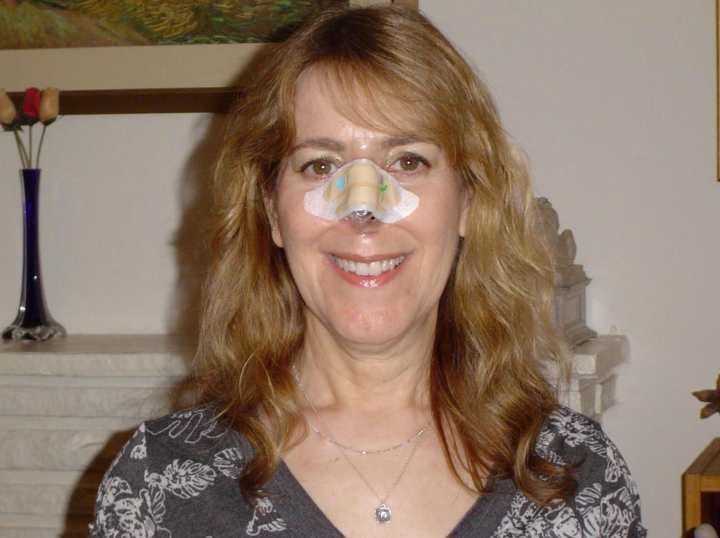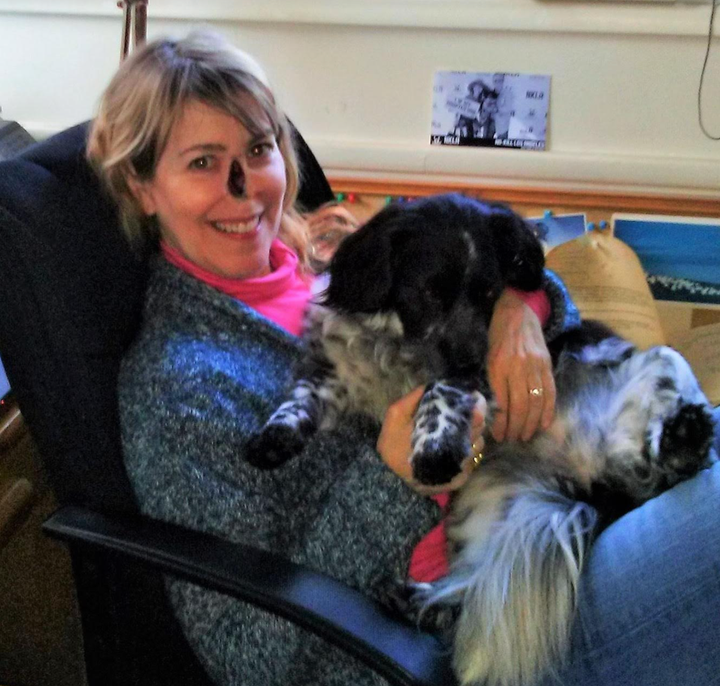
Melanoma: a pretty word for a very ugly cancer. When I was diagnosed with it nine years ago, it didn’t seem like that big of a deal. There were spots on my nose that the doctors thought could be remedied easily. But over the course of a few months, what began as “no big deal” turned into the need for a disfiguring surgery that would significantly change my life.
Let me first say I’m a lucky woman. I’ve had my share of challenges and losses, as we all have. But I have a wonderful life by most standards ― a loving husband, supportive friends and family, a good job ― and generally speaking (except for the stupid cancer thing), I am in good health.
But when you are sitting in a surgeon’s office and he tells you the best way to ensure you will be alive in five years is to remove your entire nose ― well, the word “shocking” doesn’t begin to cover it.
My husband, Paul, and I were numb as we left the doctor’s office, but when we got outside, we stood holding each other and cried, unaware of people stepping around us on the sidewalk or the traffic on Sunset Boulevard. We didn’t notice. We didn’t care. In that moment, it was the two of us facing a monster ― melanoma.
As the days passed and we prepared for my surgery, it became clear that the cancer wasn’t really what horrified me. It was the fact that I was going to become a freak ― a woman without a nose. Who ever heard of such a thing? I know plenty of people who have lost breasts, lungs, kidneys and even a testicle ― all of which are devastating and scary, to be sure. But a nose? The thing at the centre of your face that everyone can see?
I would have to wear a prosthetic and mine was going to be created by the wizards at the UCLA maxillofacial department. Their doctors put soldiers’ faces back together after combat, so they were well-equipped to give me a nose. But getting the nose was neither quick nor simple. Paul and I had a long journey ahead of us.

My doctor did a terrific job and before bandaging me up, he also crafted a clear plastic form of a nose to serve as the “bump” in the middle of my face as I recovered.
I originally believed, based on what I was told, that it would take four or five months before I would have my prosthetic, which seemed like a very long time. I am in home improvement sales, a closet designer, and every day I would go to strangers’ houses. Without a prosthetic, how was I going to face all those strangers ― let alone sell them a closet ― with a giant hole in my face?
The solution, of course, was the clear plastic nose the doctor had given me. It was the thing that was going to get me through the months of healing required before I could get my actual prosthetic. I learned how to attach it to my face using surgical tape and cover it with Band-Aids to give it a flesh colour. Then, because I’m weird and like to inject whimsy whenever possible, I used children’s stickers of flowers and stars and ladybugs to decorate it! I was going to be just fine.
That was the theory anyway. Turned out, taping that thing to my face every day was a complete pain. It never felt secure. I was always afraid it might fall off at any moment. It also had the nasty habit of creating condensation when I breathed, so water would drip out from the bottom edge. Imagine standing in someone’s home with this bizarre thing taped to your face and water dripping down your lip! Yeah, it was no picnic. Fortunately, most people were kind.
It was only supposed to be for a few months... or so I thought. The reality was quite different. The four or five months dragged on... and on... and on. The entire process of getting a prosthetic required an additional surgery to implant a device on which to clip the silicone nose and months more of healing after that. This was actually a good thing. The alternative to clipping on my prosthetic nose was gluing it on. And let me tell you, given how time-consuming and awful the daily taping of the temporary thing turned out to be, I could not imagine a lifetime of gluing my nose on each morning.
But even though I was okay with waiting a little longer for my prosthetic, since it meant I was getting a clip-on nose, I had no idea that a “little” longer meant many more months.
Rome was not built in a day and apparently, prosthetic noses aren’t either. They’re created through a fascinating process that involves sculpting wax, creating a mould for the silicone and ultimately painting it to match the color of your face. Prosthodontics requires great skill and artistry.
More than ten months after my nose was removed, I finally received my prosthetic nose. My life could return to normal ― well, a new normal, certainly.

Of course, I’m leaving out a lot of the details here ― a lot of the trauma and the crying and the emotional pain, and the recovery and the support I received from friends and family. But the point I really want to make is this: The entire experience was one of great irony.
The first, most obviously, is that out of my greatest nightmare came my dream come true.
I am a writer. I have always been a writer. I have a few published pieces and a self-published novel from 20 years ago. Before my cancer, I had stopped writing. I jokingly referred to myself as a “recovering novelist.”
When I received my cancer diagnosis and knew I had a long journey ahead of me, my niece helped me set up a page on the Caring Bridge website. For the uninitiated (and you are lucky if you don’t know what this is), the Caring Bridge site is where people going through a medical crisis can post their progress as often as they wish and all those who care about them can go to the site to learn the latest news on their loved one. It is a brilliant way for people to make their condition known without having to contact a bazillion different people just to let them know the latest. Just put the information in one place and everyone can access it.
Well, I began my Caring Bridge page for just that purpose. But as can happen when you are a writer at heart, it morphed into a daily blog where I put all my thoughts and feelings about what I was going through ― and let me tell you, I had lots of thoughts and feelings!
This was the most difficult thing I had faced in my 57 years, and processing what was happening to me was an incredible experience. And I wrote it all down.
Over and over, people told me I had to turn it into a book. I decided I would do just that once I got to the end of the process. But the truth was, once I had that horrible year behind me, the last thing I wanted to do was rehash it all to turn it into something readable. I let it go ― that is, I intended to write the book “someday,” just not “today.”
Nine years passed and the pandemic of 2020 hit. Suddenly I was home every single bloody day. How could I not use my time to finally turn the blog into a memoir? And so I did.

Noseworthy was just published by Hilltop30 Publishing Group. And so, out of my greatest nightmare, I achieved my greatest dream ― I am officially a published author. And I’m thrilled to say I’ve received the most amazing emails from people who have read it ― which is really, after all, the true realisation of the dream: that people read your work and find it meaningful.
Would I go through it all again just to be able to publish my book? No, of course not. But does it make me feel I at least got something important out of having lived through it? Yes, indeed! Lemonade out of lemons in a most significant way.
Finally, there’s one other irony I’d like to share. In my book, I talk about how relieved I was that my parents were no longer alive as I went through such a difficult year. My cancer diagnosis would have terrified them, and it would have killed them to see me struggle through the emotional trauma of losing my nose. So, as much as I miss them both, I was glad they were not there to suffer through it with me.
Fast forward to today ― when I’ve achieved a goal I’ve wanted my entire life. My parents would have been over the moon about the publication of Noseworthy. My father had a journalism degree, though he was a journalist for only a short time. But he was always a wordsmith by nature and a writer at heart. Now, instead of being glad my parents are not here, I’m incredibly sad neither of them is alive to see this happen.
So there they are ― two ironies intertwined. My dream come true sprung from my worst nightmare, and my relief that my parents did not have to witness something horrible only to not be able to share my proudest moment with them.
Life is bizarre sometimes. But after what I’ve been through, I’m just happy to be here. Even if it meant giving up my entire nose, I still got the best end of the bargain.
This article first appeared on HuffPost Personal
Have a compelling personal story you want to tell? Find out what we’re looking for here, and pitch us on ukpersonal@huffpost.com